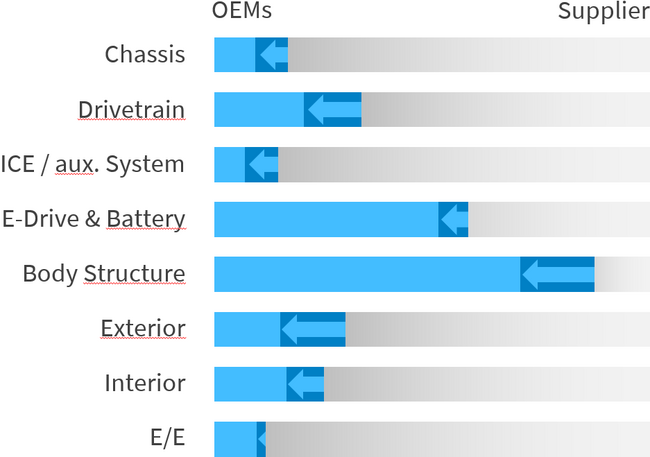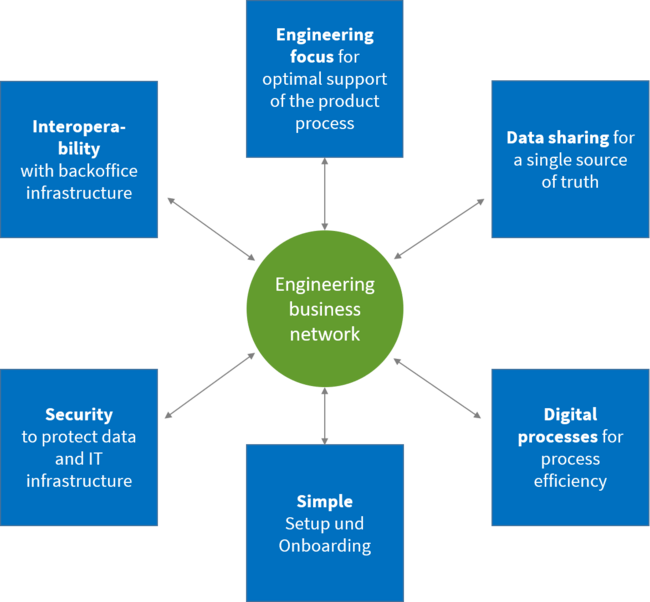Multi-Enterprise Integration:
The new Collaboration Hub
Email and Team-Space solutions are quick to set up and easy to use. In the engineering environment, however, they quickly reach their limits. Collaboration Hub is a new offering for companies that want to collaborate more efficiently in product development. It focuses on three use cases.
Today, high-quality products are no longer conceivable without the know-how and components of partners and suppliers. The share of in-house production by car manufacturers has fallen to below 25% and they are increasingly entering into joint ventures in order to meet the ever-increasing costs of innovation. Today, cooperation with engineering offices, suppliers, the customer and partners is essential for efficient product development. Companies are faced with many challenges, because
- the IT tools for executing the processes are not connected
- the data is difficult to use
- the collaboration with business partners is time-consuming
According to the market research company Gartner, traditional supply chains mainly use internal, company-related data. "This leads to delayed updates and limited visibility... From a technology perspective, this leads to reliance on legacy solutions and often an internal monolith," the experts say.

Engineering projects quickly reach their limits with conventional IT tools
Traditional methods still play a major role in engineering projects. For example, e-mails are still popular because of their ease of use. In addition, there are special services such as Transmittal Management and the EDI-controlled exchange of product data. However, these procedures are not sufficient to ensure distributed value creation.
No message-oriented tool fulfils a decisive requirement: A common environment in which all project participants can keep themselves informed at all times. This does not only apply to a single item, but also to requirements, installation spaces, comments, redlining, previous statuses and much more.
New services such as Slack or Microsoft Teams, which provide a Team Space, promise a remedy. But they ignore the special needs of engineering due to their universal claim.
Collaboration Hub: A new edition of CONTACT Elements Standards
This is why we have developed Collaboration Hub. The starting point is the Elements portfolio consisting of standard building blocks for technology, core services and specialist applications along the product development process - supplemented by PLM connectors from PROSTEP AG, for example, to connect partners or company divisions with different PLM systems. Collaboration Hub specifically supports the following areas:
Joint Ventures
A joint venture is a long-term cooperative business relationship, such as the merger of the mobility services of Daimler and BMW. Joint ventures must
- synchronize data and processes across the systems of the participating organization
- offer a common system environment according to the need-to-know principle, which supports employees in their daily work
- prevent access to sensitive company data
The core elements of Collaboration Hub for joint ventures are Legacy system interfaces, dedicated application environment and intellectual property protection.
Joint Projects
Here, various companies are pursuing a common goal, for example the development of a new drive system. The focus here is on requirements such as advanced process and workflow concepts, context links to elements of the product structure and special access rules. Joint projects must
- be able to set up a common environment quickly and efficiently
- strictly prevent access to data that is not intended for this
- apply industry standards such as the BIM standards or, in the automotive industry, STEP AP 242 and JT
The core elements of Collaboration Hub for cross-organizational projects are: dedicated application environment, out-of-the-box capability with on-premise or public/private cloud deployment, intellectual property protection and industry standards.
Supplier Integration
In supply chains, suppliers and engineering companies fulfill tasks such as detailed design, validation or technical modifications by order of the engineering lead. Collaboration Hub supports this, for example, with workflows for defining, confirming, executing, and checking technical changes. These services require lightweight support with short start-up times. Suppliers must be able to
- access all relevant information via a 24/365 self-service portal
- to easily download and upload complex data such as CAx model structures and immediately identify subsequent changes
- to use collaboration features such as activity streams, subscriptions, redlining and task management.
The self-service supplier portal is based on the following core elements of the Collaboration Hub: Workspaces, triggers & alerts, lightweight collaboration, workflows, fast on- and offboarding, access control by context and security.

How do companies use Collaboration Hub?
Depending on the use case, the following options are the focus:
Users continue to use their legacy system - typically an internal PLM system - as usual. Objects relevant for collaboration with partners are automatically synchronized with a target system via the hub. Examples are the parts and documents of a project that are kept synchronous in two or more systems.
Alternatively, users can work directly in the hub's user interface. This is the case if the legacy system itself does not provide adequate support for the required project and business logic or if the comprehensive connection of legacy systems is not economical for a large number of partners. An example is a shared workspace on the web or in the cloud for an engineering project.
The third option is a separate portal interface on the Web, especially for suppliers. Such a portal reflects selected sections of the data and processes of the company's own PLM backbone in the cloud. This mirroring takes place automatically and provides suppliers with all necessary product and process data virtually in real time. Which data is mirrored and when is determined once at the start of a process or project by rules, which minimizes effort and sources of error.
What makes Collaboration Hub unique from other solutions?
Collaboration Hub targets primarily engineering projects and offers direct support for the structures and processes typical there.
One example is CAD models and their complex structural data (assemblies and installation spaces). In addition to the direct mapping of this data, the main aim is to inform users about changes. In the best case, this is done using the structural and model data, for example by using automatic difference analysis to directly display the differences in the 3D CAD model.
Overview and comfort in view of dozens or hundreds of objects in such structures require intelligent data sharing. Intelligent sharing means that configurable rules based on status characteristics at the objects ensure that the data is provided automatically, virtually in real time.
Finally, we position Collaboration Hub as an easily configurable enterprise-class solution. The business and functional scope of the CONTACT Elements portfolio allows scalability up to very large projects with thousands of users. This also includes the comprehensive roles and rights system and the security concept using a proxy environment, which is decoupled from the internal systems behind the firewall.
Conclusion:
Developing products is like playing together in an orchestra, only not all of them are gathered in one room. Special tools are needed to achieve a distributed value creation as in internal processing. Collaboration Hub is a configuration of CONTACT Elements and supports the rule-based intelligent sharing of data along the processes in the PEP. The focus is on the use cases Joint Ventures, Joint Projects and Supplier Integration. Thus, efficiency gains are now also transferable to cross-company collaboration.

